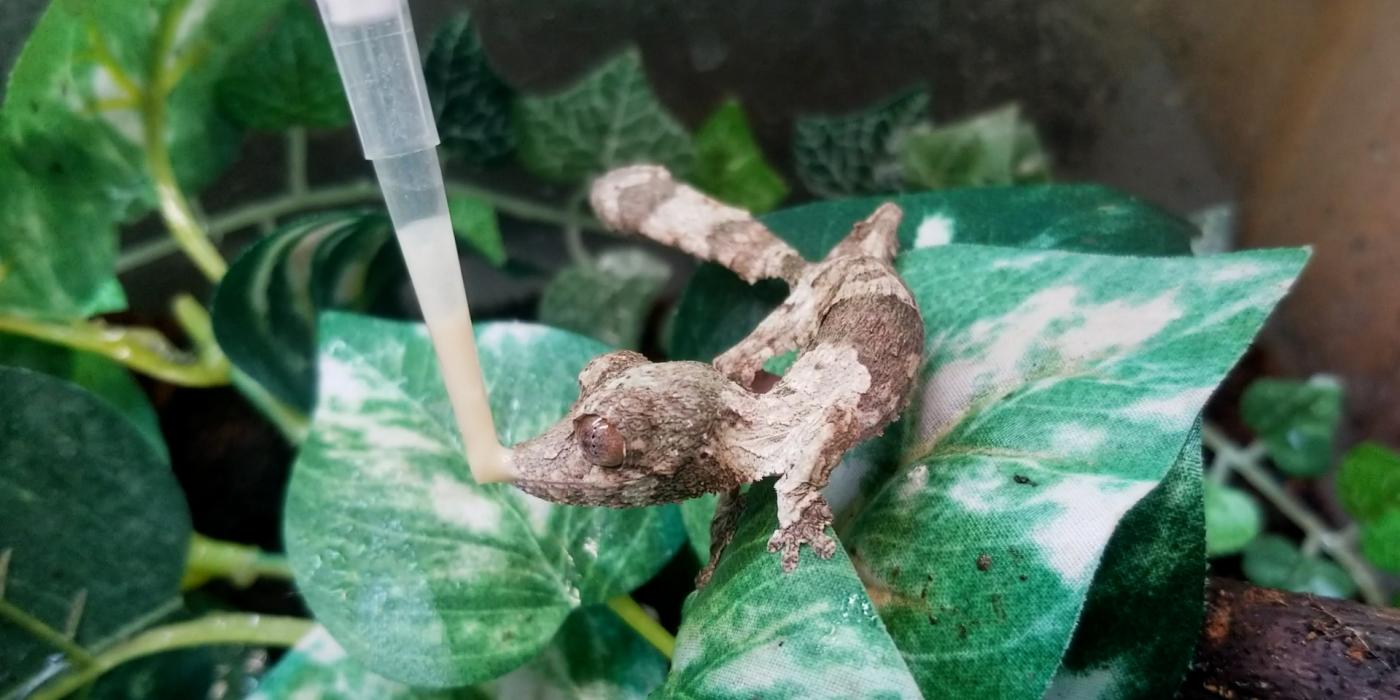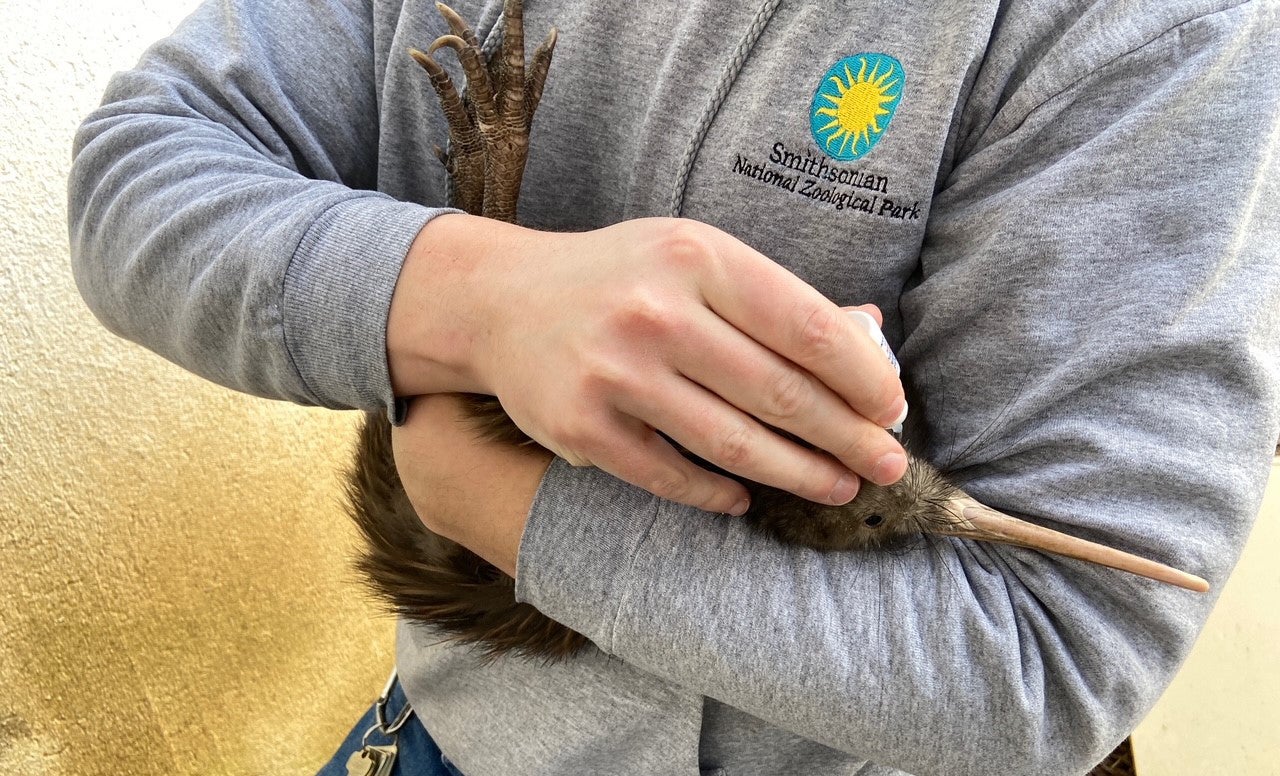How Do You Give Medicine to Zoo Animals?

How do you get an elephant to exercise, safely introduce two songbirds or prepare a cheetah for a veterinary exam? In this series, get an insider’s look at how animal keepers use activities, food, training and toys to care for the Smithsonian’s National Zoo’s animals. Find out how enrichment stimulates the senses, why training builds trust, and how keepers come up with new ways for animals to explore and use their natural behaviors each day.
Do you have any pets at home — a dog or cat, maybe even some fish or a bird? Have you ever needed to give them medicine prescribed by a veterinarian? If you have (or if you can imagine it), then you know that sometimes medicating animals can be a challenge. Think about trying to give a pill to a cat. Now, imagine that cat weighs over 300 hundred pounds and has giant teeth, like our Amur tiger. A tiger is too big to pull out from under the bed, wrap in a towel and open its mouth to place a pill inside.
The Smithsonian’s National Zoo and Conservation Biology Institute is home to hundreds of animals comprising a wide variety of taxa, from bugs to bison, salamanders to siamangs, prairie dogs to pandas, and everything in between. Regardless, all of our animals receive veterinary care, and often that means an animal needs to take medicine.
Our Department of Wildlife Health Sciences includes veterinarians, technicians, pathologists and nutritionists that ensure every single animal receives the highest level of care. They examine the animals in our care and prescribe the best course of action for any ailment. An animal may have a new problem, like a wound that needs attention, or a chronic problem, like arthritis. Medication can take several forms — pills, capsules, liquid suspensions (medicine mixed into a liquid) or even injections. Ensuring that an animal receives its full dose of medicine, as often as necessary, takes a bit of creativity.
A medication method used by many keepers involves placing a grape on the end of a syringe, with the syringe tip sticking out. When an animal, like this red panda, opens its mouth to eat the grape, the keeper can squirt its medication into its mouth.
It is important to determine which avenue of medicating will be the most efficient for each animal. Is an animal more likely to take their medicine in a pill form or a liquid form? Do they have a favorite flavor or food? As a primate keeper, I can tell you that bubble gum or marshmallow flavored liquid medicine suspensions are always the best for the picky primates!
Often, training plays an important part in the success of giving an animal medicine. The seals and sea lions that live on American Trail, for example, are trained to hold still while keepers administer their eye drops. As pinnipeds (seals, sea lions and walruses) age, they can develop inflammation in their eyes. Keepers train all the Zoo’s pinnipeds to hold still like this, regardless of their age, as a proactive measure to support their health in the future. By making this a trained behavior, keepers can call the pinnipeds out of the water when needed, position their heads, and have them hold still while the drops are put into their eyes. The seals and sea lions then receive a reward, making it a win-win situation for both the animals and the keepers.
Many factors come into play when determining how best to give an animal medicine, but the conversation always starts between the animal care and veterinary teams. Zoo keepers pride themselves on knowing the animals in their care, both their natural history (where they live, their social groupings, their diets) and each animal as an individual (this animal likes grapes but not apples and eats more readily in the late afternoon).
The Department of Wildlife Health Sciences also provides a detailed medication sheet with each prescription. A keeper signs off on every sheet to confirm that a medication was given as often as prescribed and to note whether an animal took all of its medication.
Training can even occur before medications are needed, allowing keepers to proactively prepare for how to give an animal medicine in case the need arises later. At the Smithsonian Conservation Biology Institute, keepers are working with the herd of Persian onagers to help them get comfortable with a keeper approaching the fence around their habitat and using medical objects like syringes.
This type of training is called desensitization. The onagers are called to the fence and given treats, while keepers hold syringes close to the onagers’ mouths. If the onagers are prescribed medication in the future, the medicine could be squirted into their mouths using a syringe — an object and routine they are now familiar with.
Injection training is also enormously important for many of the animals under our care. This type of training utilizes positive reinforcement. Animals can always walk away, but if they choose to participate, they receive their favorite food as a reward. Injection training starts with animals learning to present a body part to keepers. For infant gorilla Moke, it was his shoulder. We progressed to touching his shoulder with a finger, then with a capped syringe and finally a blunted needle. To receive a reward, all Moke needed to do was hold still. Repeated training sessions like these get animals used to holding still for injections.
When animals can comfortably, calmly and voluntarily receive injectable medications, vaccines or anesthesia, it creates a less stressful experience not only for the animal, but also for keepers and veterinarians. Are you, or anyone you know, afraid of needles? A nurse may take the time to talk you through the process to put you at ease, and may even give you a lollipop when it is all over. The same principle applies to training animals for injections. But keepers and veterinarians rely on the trust they build with an animal, rather than an animal’s ability to understand an explanation of what is happening.
Many medications that are prescribed to animals at the Zoo and Conservation Biology Institute are intended to be taken by mouth. This can look vastly different depending on the species. Let’s take reptiles, for example. Most reptiles do not chew their food, and some species do not eat every day. So, when Murphy the Komodo dragon needs to take a pill, the entire thing can be shoved inside a piece of chicken, his favorite food, which he readily gulps down.
Liquid medicines can also be injected into frozen-thawed mice that are fed to reptiles, ravens and other carnivores. What animal could pass up a tasty mouse treat, even when it contains medicine? It may sound gross, but rest assured that it is a highly reliable way to medicate some of the animals at the Zoo. This same technique can also be used for small mammals and birds, but with different food items. Mealworms, wax worms and insects can be injected with medications and are then gobbled up quickly by these smaller animals.
Primates are particularly picky when it comes to medications. Not only can they be suspicious of foods that smell or taste different, but they also often live in social groups. Great care is taken when medicating any animal that lives in a social group to ensure that the right animal receives the right medication, and that medicine is never taken by another animal in the group.
Sometimes, a grape is given to each monkey in a group to keep them occupied, while a special grape containing medicine is handed to the right recipient. Medications can also be mixed into yogurt or applesauce and spoon-fed directly to an animal.
For giant pandas Mei Xiang and Tian Tian, medications are often mixed into one of their favorite foods, cooked sweet potatoes. Because the pandas enjoy sweet potatoes so much, this method is effective in making sure they receive their full dose of medication without much effort.
Another difference in giving medicine to zoo animals compared with animals you may have at home is that it is not always safe for keepers to be in the same space with an animal. Some birds, small mammals, reptiles and invertebrates can be picked up and held gently while administering medicine. At the Smithsonian Conservation Biology Institute, for example, keepers can cradle the brown kiwi gently and securely in their arms to give them eye drops.

In some cases, however, keepers always work with animals behind a barrier. In the zoo world, this is called protected contact. Many of the Zoo’s larger and stronger animals require protected contact, meaning a keeper is never in the same space as the animal. Tigers, great apes and bears naturally come to mind, but did you know that there is a bird species on the list, too?
At the Bird House, keepers work with cassowaries using protected contact due to the birds’ strength and mighty kick! When working animals in a protected contact situation, keepers must develop a medication plan that involves making sure the animal is willing to come up to the barrier to take its medicine. This is where the importance of establishing trust with an animal comes into play again.
A keeper has to make taking medication worth an animal’s time and energy, which is why favorite foods are often used. This type of positive reinforcement training is widespread around the Zoo. Desired behaviors, like holding still for eye drops or approaching a barrier, are rewarded with tasty treats. When a keeper calls to an animal, the animal knows that it will receive praise, attention and food rewards for responding. Positive reinforcement training helps to establish that important bond between an animal and a keeper.
It is not an easy job to diagnose and treat such a diverse collection of animals. From the smallest invertebrates to the largest mammals, each species has different needs. Thanks to the dedication of our animal care staff and wildlife health sciences team, we are able to provide the best care to our animals and ensure their continued health and wellbeing.
Our whole team works diligently to care for our animals and keep you connected to the Zoo. With your support, our conservation mission continues. If you can, please join us in this important work by making a donation today. On behalf of the animals we care for and work to protect: thank you.


